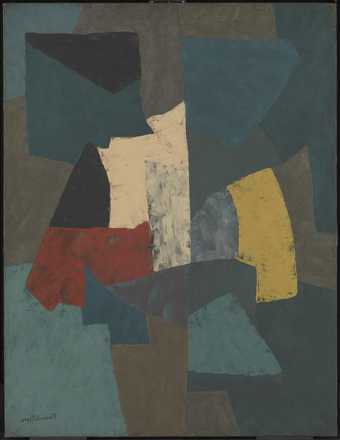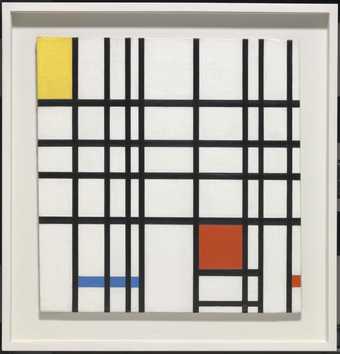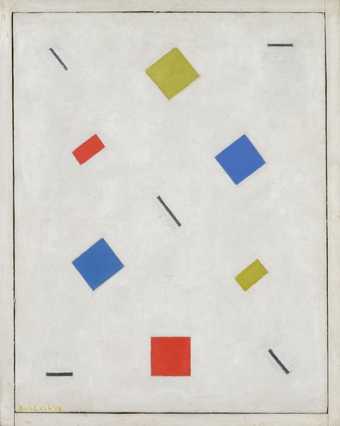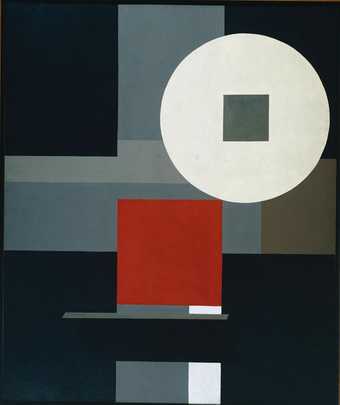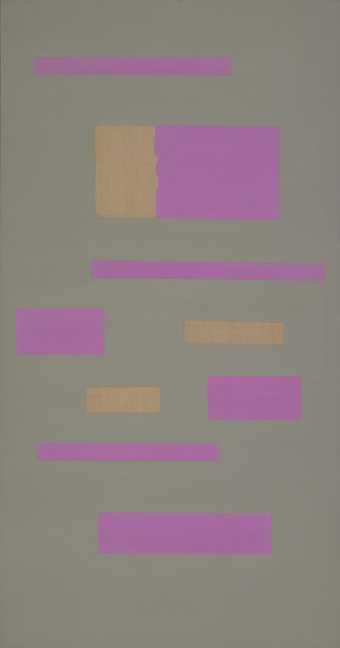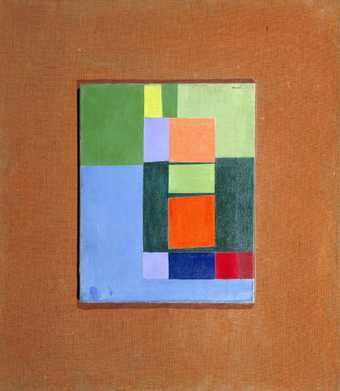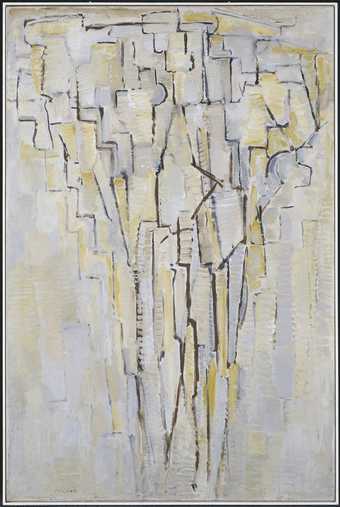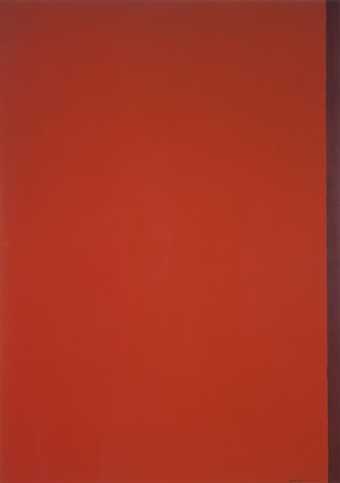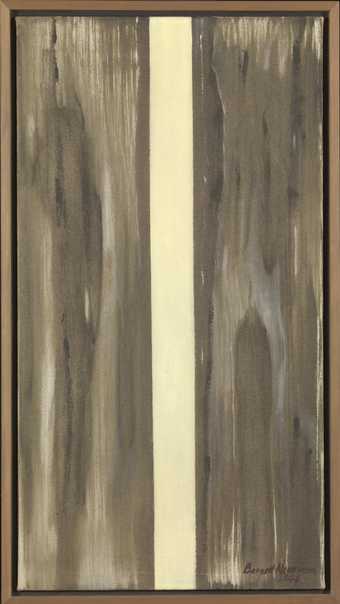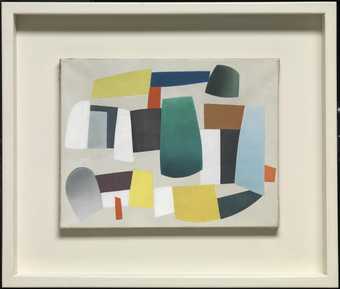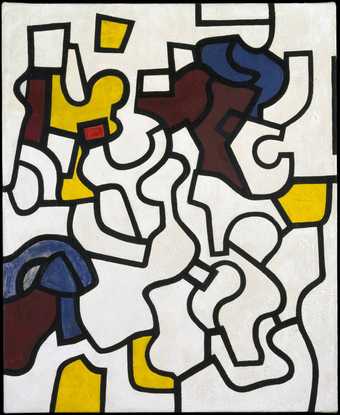
In Tate Modern
Exhibition
Hilma af Klint & Piet Mondrian: Forms of Life
Explore the powerful work of two groundbreaking modern artists
- Artist
- Piet Mondrian 1872–1944
- Medium
- Oil paint on canvas
- Dimensions
- Support: 803 × 633 × 24 mm
frame: 1188 × 1015 × 91 mm - Collection
- Tate
- Acquisition
- Accepted by HM Government in lieu of tax with additional payment (General Funds) made with assistance from the National Lottery through the Heritage Lottery Fund, the Art Fund, the Friends of the Tate Gallery and the Dr V.J. Daniel Bequest 1999
- Reference
- T07560
Summary
Accepted by H.M. Government in lieu of tax with additional payment (Grant-in-Aid) made with assistance from the National Lottery through the Heritage Lottery Fund, the National Art Collections Fund and the Friends of the Tate Gallery 1999
T07560
Piet Mondrian arrived at his mature style of 'pure' abstraction around 1920, while living in Paris. He shunned all references to nature, and restricted himself to squares or rectangles of primary colours, set in white fields and bounded by intersecting straight lines. His canvases expressed, he believed, the principles of 'plastic equivalence', or what he termed 'neoplasticism'. With planes of primary colour balancing planes of non-colour (white, grey or black) and vertical lines opposing horizontal lines, and both acting to define the planes, his works embodied, he thought, principles of balance and harmony. He saw his carefully composed canvases as microcosms, or emblems, of a perfect equilibrium in art and in all spheres of life, and hoped that 'neoplastic' principles would underlie a future ideal society.
Around 1932 Mondrian began to seek a new 'dynamic equilibrium' in his work. In a text called 'The True Value of Oppositions in Life and Art', written in 1934, he explained his new ideas:
Intuitively, man wants to be good: unity, equilibrium - especially for himself. Thus he falls back into the search for false ease and static equilibrium which is inevitably opposed to the dynamic equilibrium of true life It is quite natural that he seeks only 'the best' among the oppositions that life offers, and this is what he experiences as unity. However, life shows us that its beauty resides in the fact that precisely these inevitably disequilibrated oppositions compel us to seek equivalent oppositions: these alone can create real unity, which until now has been realised only in thought and art. (Holzmann and James, pp.283-5)
In Mondrian's later works, such as Composition B with Red, lines no longer simply denoted the boundaries of the coloured planes. Instead they traversed the length and breadth of the canvases and became the most active elements in the compositions. The dynamic crossing of lines prevented the coloured planes from being seen as static entities, while the unequal intervals between the lines created a visual rhythm.
In Composition B with Red Mondrian allowed line to be the most important element within the composition. Two vertical lines and two horizontal lines, covering the canvas from edge to edge, describe a cruciform shape. The width between the two vertical lines is narrower than that between the horizontal pair, and this imbalance creates a visual sensation of 'pull and push'. In addition, the intersection of the lines creates an optical 'flicker', or a series of retinal afterimages, which animates the surface. The nine unequal rectangles or planes created by the cruciform shape appear to jostle for visual dominance. The top-left square of red - the only accent of colour in this composition - is held in check by these other planes. In particular, the white plane underneath the red is given extra definition and visual weight by the subtle addition of a short vertical line between the two main horizontal lines at the extreme left edge of the canvas.
Mondrian was in his early sixties when he painted Composition B with Red and was recognised as one of the principal originators of abstraction. He had been a central figure in the Dutch De Stijl movement in the early 1920s and was active in the Paris-based international organisation Abstraction Création in 1931-4. The utopian aspects of his vision and, above all, the uncompromising rigour of his approach made his works a touchstone of purity and perfection for a new generation of artists. In 1935, Composition B with Red was among a group of works that he showed in the important post-Cubist survey exhibition thèse, antithèse, synthèse held at the Kunstmuseum in Lucerne
Geometrical abstraction was unfashionable among collectors in France and Mondrian sold only three paintings in 1935, the year he completed Composition B with Red. However, his reputation abroad grew over the course of the 1930s, particularly in Britain and the USA, countries eager to 'catch up' with continental avant-garde art. It was through the British painters Winifred Nicholson (1893-1981), then based in Paris, and Ben Nicholson (1894-1982) that Nicolette Gray (1911-97), a young medieval historian and passionate supporter of contemporary art, first met Mondrian. In association with the newly established art magazine Axis, Gray organised in early 1936 an exhibition entitled Abstract & Concrete. As well as Composition B with Red and two other paintings by Mondrian, Gray's selection included works by such artists as Jean Arp (1888-1966), Naum Gabo (1890-1977), Jean Hélion (1904-87), Ben Nicholson (1894-1982) and Barbara Hepworth (1903-75). Although it travelled to Oxford, Liverpool, London and Cambridge between February and June, the show was neither a commercial nor a critical success. It was, however, indicative of the lively reception of 'constructive art' among intellectuals in Britain. This welcome encouraged Mondrian to move to London under the threat of war in September 1938, until the Blitz drove him on to New York in 1940.
Of the three paintings by Mondrian in Abstract & Concrete, Nicolette Gray bought the smallest, Composition C with Red, Yellow and Blue, 1935, also known as Composition with Red and Blue (Tate L00097) after the show had ended. Helen Sutherland (1881-1965), a friend and wealthy patron of the arts, bought Composition B with Red from the exhibition in London. Sutherland was a close friend of Winifred and Ben Nicholson, and gave precious financial and moral support to many artists. On her death she bequeathed her collection, including Composition B with Red, to Nicolette Gray.
Further reading:
Michel Seuphor, Piet Mondrian: Life and Work, London 1957, reproduced p.390
Harry Holtzman and Martin S. James (eds.), The New Art - The New Life: The Collected Writings of Piet Mondrian, London 1987, reproduced fig.201
Yve-Alain Bois, Piet Mondrian 1872-1944, Milan 1994, reproduced p.68
Joop M. Joosten and Robert P. Welsh, Piet Mondrian: Catalogue Raisonné, New York 1998, volume II, pp.376-7, no.B254, reproduced p.376
Jennifer Mundy
February 2002
Does this text contain inaccurate information or language that you feel we should improve or change? We would like to hear from you.
Display caption
Here Mondrian reduces his use of colour to a single red rectangle. This gives the black lines greater visual importance. The structure is slightly off-set. Mondrian rejected the ‘false ease’ of symmetry. He preferred ‘the dynamic equilibrium of true life’ and tried to create a visual representation of this. Mondrian aimed to create a new art for the modern world. His geometric abstraction was a clear departure from traditional painting. He connected this new kind of art with a pursuit of a new spirituality.
Gallery label, August 2020
Does this text contain inaccurate information or language that you feel we should improve or change? We would like to hear from you.
Explore
- abstraction(8,615)
-
- non-representational(6,161)
- formal qualities(12,454)
You might like
-
Serge Poliakoff Abstract Composition
1954 -
Piet Mondrian Composition with Yellow, Blue and Red
1937–42 -
Bart van der Leck Composition
1918 -
Piet Mondrian No. VI / Composition No.II
1920 -
Friedrich Vordemberge-Gildewart Composition No. 15
1925 -
Ad Reinhardt Abstract Painting
c.1951–2 -
Kenneth Martin Composition
1949 -
Piet Mondrian The Tree A
c.1913 -
John Bigge (Sir John Amherst Selby-Bigge, Bt) Composition
1933 -
Barnett Newman Eve
1950 -
Barnett Newman Moment
1946 -
Piet Mondrian Sun, Church in Zeeland; Zoutelande Church Facade
1909–10 -
Jean Hélion Abstract Composition
1934 -
Judith Rothschild Untitled Composition
1945 -
Saloua Raouda Choucair Composition with Two Ovals
1951

